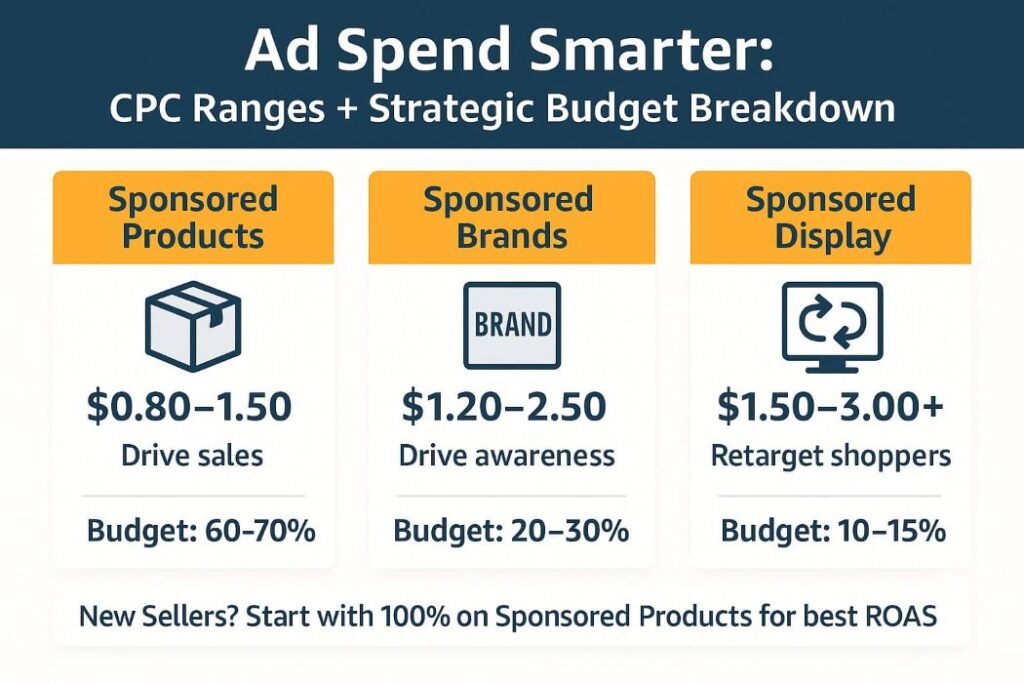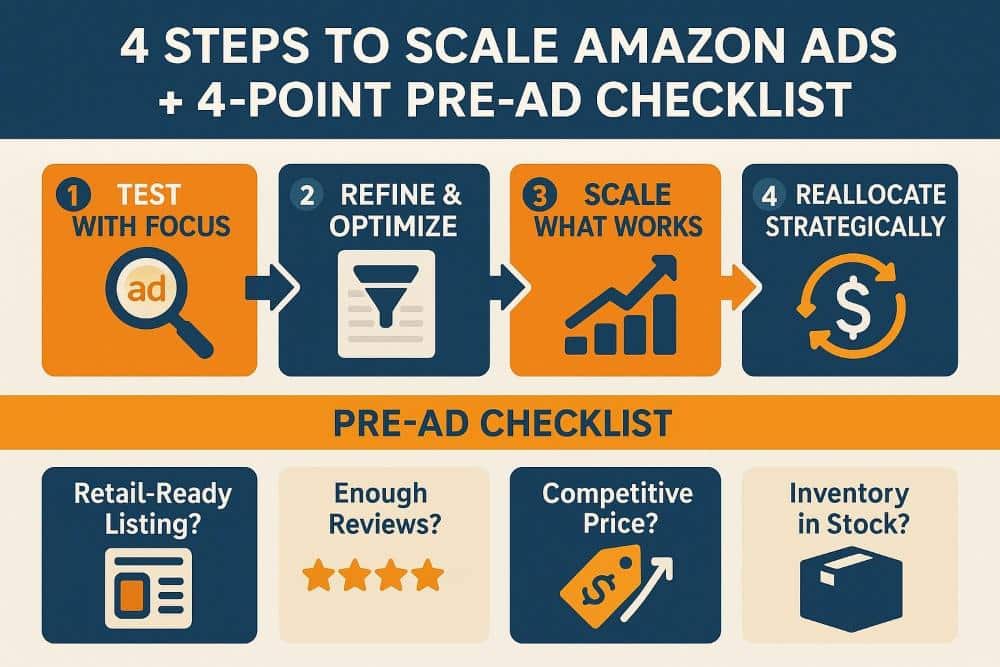29 July 2025
Amazon Ad Bid Modifiers: Optimizing Bids by Placement
TweetLinkedInShareEmailPrint If you’ve ever wondered how to get your Amazon ads in front of more buyers...

If you’ve ever stared at your Amazon Campaign Manager and asked, How much should I actually spend on ads to get results?
—you’re asking the right question. For countless US-based Amazon sellers, determining the right minimum Amazon ad budget feels like a shot in the dark. Spend too little, and your products remain invisible. Spend too much without a data-driven plan, and you’ll burn through capital with nothing to show for it.
The truth is, there’s no magic number that works for everyone. But there are expert-backed frameworks that can guide you to your “sweet spot”—an ad spend that drives sales, gathers crucial data, and delivers a profitable return.
This guide is your complete roadmap. We’ll break down exactly how to set, test, and scale your ad budget with confidence, transforming your ad spend from an expense into your most powerful growth engine.
Article Contents

In the very competitive Amazon marketplace of today, a “minimum” budget isn’t the least amount you can technically spend (like $5 a day).
The minimum Amazon ad budget is the least amount you should pay to reach two important goals:
It’s the money you need to spend to launch your rocket. That figure changes depending on the type of product you sell, the aims of your campaign, and how long your account has been open. We’ll go over all of these things below.

To set a budget, you first need to know where the money goes. Amazon’s main ad types serve different strategic purposes and come with different costs.
| Ad Type | Average CPC (US, 2025 Estimate) | Primary Objective |
| Sponsored Products (SP) | $0.80 – $1.50 | Drive conversions for individual products. These are the most common ads you see in search results and on product pages. |
| Sponsored Brands (SB) | $1.20 – $2.50 | Build brand awareness and drive traffic to a collection of products or your Storefront. Features your logo and a custom headline. |
| Sponsored Display (SD) | $1.50 – $3.00+ | Retarget shoppers who viewed your products, target competitor listings, and reach audiences based on shopping behaviors. |
Tip: If you plan to invest in Amazon Sponsored Brand Ads Management or Amazon Sponsored Display Ads Management, you’ll want to allocate extra budget for these more competitive formats.
Note: Costs-per-click (CPCs) vary wildly. A seller in a low-competition niche like handmade crafts might see CPCs under $1, while one in the supplements or electronics category could easily face CPCs of $3 or more.
For sellers working with a limited budget, the allocation is critical:
If you’re starting out, put 100% of your initial ad spend into Sponsored Products. They are the most efficient way to turn clicks into sales and gather performance data.

Your Amazon ad costs don’t just happen on their own. There are a number of things that have a direct effect on your CPCs and total spending. If you learn how to use them, you can make even a tiny budget go further.
There are three major things you can do on Amazon.
Additionally, new sellers often wonder whether to choose Manual PPC or Automated PPC campaigns. The right choice depends on your experience and goals, but many start with automated campaigns to collect data, then shift to manual campaigns for greater control.
The quality of your traffic depends on how you target keywords. Using Amazon Search Term Optimization effectively here can make a big difference.
Amazon’s algorithm becomes confused when a campaign structure is complicated. Putting unrelated items and keywords into one ad group will lower your relevance score and raise your CPCs. Single keyword ad groups and other well-organized campaigns make ads more relevant and lower expenses.
The economics of your goods have a direct effect on how well ads work. If CPCs are over $1.50, it can be hard for a cheap item (around $20) to make money. On the other hand, a high conversion rate is your best buddy because it implies you need fewer clicks to generate a transaction, which lowers your Advertising Cost of transaction (ACoS). Understanding what is a good ACoS on Amazon for your category will help set realistic expectations.
New accounts typically find themselves in an invisible sandbox
where they get more clicks but fewer impressions. Amazon’s algorithm is more likely to give you special attention if your account has a lot of sales, good ratings, and performance statistics.
The CPC goes up when more merchants bid on a keyword. Also, bidding for premium spots like “Top of Search” will always cost more than bidding for spots on product pages or at the bottom of search results.

It varies based on the factors listed above, but here are some expert-backed guidelines for how much money to spend on ads each day based on where your business is at.
The smartest sellers don’t just choose a random number; they work backwards from their goals. This method uses data analysis instead of feelings to make sure that your spending is in line with your business goals.
Here’s a simple formula to calculate your target ad spend:
(Target Ad Sales / Average Product Price) / Conversion Rate * Average CPC = Required Monthly Ad Spend
Let’s see it in action.
Scenario A: Mid-Range Product
Scenario B: High-Ticket Product
This formula makes it clear that your minimum Amazon ad budget is deeply connected to your product’s specific metrics.

Setting the initial budget is step one. Growing it intelligently is what separates top sellers from the rest. Follow this proven four-step process.
Additionally, using advanced Amazon PPC Software can help automate this process and provide deeper insights for scaling effectively.
Advertising magnifies what’s already there. If you drive traffic to a poor listing, you’ll only get poor results faster. Before you commit to your minimum Amazon ad budget, ensure your foundation is solid.
1. Is Your Product Detail Page Retail-Ready?
Your images must be high-resolution and compelling. Also, your title and bullet points need to be optimized with keywords while clearly communicating customer benefits. Your A+ Content should tell your brand story and handle common objections.
2. Do You Have Enough Social Proof?
Advertising a product with fewer than 15-20 reviews (and a rating below 4.0 stars) is an uphill battle. Clicks won’t convert if shoppers don’t trust your product. Use programs like Amazon Vine or post-purchase follow-ups to build reviews before spending heavily on ads.
3. Is Your Price Competitive?
Shoppers are expert comparison tools. If your product is priced significantly higher than your direct competitors without a clear reason (e.g., superior quality, better bundle), your conversion rate will suffer, and your ad spend will be wasted.
4. Do You Have Sufficient Inventory?
Nothing stops momentum faster than running out of stock. If you don’t have enough stock, running advertisements is a sure way to fail. Make sure you have at least 30 to 45 days’ worth of stock on hand to keep up with the faster sales that your promotions will bring in.
If you can’t say “yes” to all four, pause and fix these fundamentals first. A well-optimized listing will always achieve a better return from the same ad budget. It is the best way to protect your investment in your minimum Amazon ad budget.
It’s not just about getting one number that shows your minimum Amazon ad budget. Also, it is about developing a strategy that can increase over time. It’s about going from speculation to a plan based on data that fits your individual aims.
Finding the sweet spot is the key. You need an advertising budget that enables you to test, learn, and grow without wasting money or missing out on crucial market share. Keep in mind that this budget can change. Moreover, as your product gets better, your conversion rates go up, and your goals change, it should alter too. Your ad expenditure is the most effective tool you have to help your business develop on Amazon if you use it wisely.
Do you want to stop guessing about your ads and grow with confidence? Contact the SellerMetrics team today to set up a personalised strategy session.
While Amazon technically allows campaigns with a $1 daily budget, most experts agree the effective minimum is $25–$30 per day. This amount allows your campaigns to gather enough clicks and impression data within a reasonable timeframe (about a week) to make smart optimization decisions.
You can, but the results will be extremely limited and slow. At $5/day in a competitive US market, you might only get a handful of clicks. This makes it nearly impossible to gather meaningful performance data, and your ads will rarely have enough budget to run for the full day. Finding your minimum Amazon ad budget is about effectiveness, not just spending something.
Depending on how competitive your product is, a typical launch budget for the first month is between $500 and $2,500. This usually means a daily expenditure of $25 to $75, mostly for Sponsored Products ads to achieve the first sales, improve keyword ranking, and get important reviews.
Yes, a good starting budget for beginners is between $25 and $50 each day. This lets you run a few focused Sponsored Products ads without spending a lot of money, giving you enough click data to figure out what works and what doesn’t.
Not necessarily. Profitability is more dependent on efficiency than on budget size. A seller with a highly optimized listing, a great conversion rate, and a smart campaign structure can be profitable with a smaller budget. However, a larger budget provides more data faster and allows for more aggressive scaling.